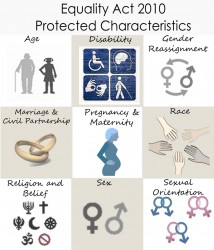The Equality Act 2010 www.legislation.gov.uk/ukpga/2010/15/contents identifies nine protected characteristics: age, disability, gender reassignment, marriage and civil partnership, pregnancy and maternity, race, religion or belief, sex and sexual orientation. The Act protects people from direct and indirect discrimination, harassment and victimisation because of a protected characteristic. The Act’s scope covers the provision of goods and services, including things provided for free, employment (work), associations, education and premises. The Act allows positive action where certain conditions are met and requires reasonable adjustments to be made for disabled people. A reasonable adjustment can include removing a barrier, providing the service in a different way and changing the way information is provided. The Act requires an organisation to anticipate what disability adjustments may be needed in advance. In relation to health and wellbeing, as well as ensuring equality in terms of people’s experience of treatment by health services, it is important to understand the impact of these characteristics on health, and to ensure groups have equitable access to health services in relation to the health, care and wellbeing needs they exhibit. Figure 4.1 and Table 4.1 describe the nine characteristics.
Figure 4.1, Protected Characteristics from the Equality Act 2010

Table 4.1, Definitions of the nine protected characteristics in the 2010 Equality Act
| Protected Characteristic | Definition |
| Age | A particular age (for example, 32 year old) or a range of ages (for example, 18 – 30 year olds) |
| Disability | A person who has, or has had, a physical, sensory or mental impairment which has a substantial and long-term adverse effect on their ability to carry out normal day-to-day activities |
| Gender reassignment | A person who is proposing to undergo, is undergoing or has undergone gender reassignment (this may or may not include surgical or medical intervention) |
| Marriage and civil partnership | A legally recognised union between two people |
| Pregnancy and maternity | Maternity includes 26 weeks after giving birth and breastfeeding |
| Race | Colour, nationality, ethnic or national origin |
| Religion and belief | Religious and philosophical beliefs including lack of belief. Generally, a belief should affect your life choices or the way you live for it to be included in the definition |
| Sex | A man or a woman |
| Sexual orientation | A person’s attraction towards someone of the same sex (lesbian or gay), the opposite sex (heterosexual) or to both sexes (bisexual) |
The Act also includes a Public Sector Equality Duty (PSED). The duty applies to all public authorities and those providing a public service (where this is transferred out). The PSED requires public authorities to ‘give due regard to the need to’ (consider the extent to which it can): eliminate discrimination, advance equality of opportunity and foster good relations in relation to the protected characteristics. The duty to advance equality of opportunity includes the need to remove or minimise disadvantage, meet people’s needs, take account of disabilities and encourage participation in public life (such as consultation and decision making). The PSED also places specific duties on public authorities to publish equality objectives and information about how people are affected by policies and practices.
A person’s health is influenced by a wide range of factors, known as wider determinants of health (page 15, figure 2.2) such as individual characteristics (age, sex and genetics), lifestyle, community involvement and local economy. Where protected characteristic groups experience differences in these wider determinants of health this can lead to health inequalities. For example, taking the protected characteristic of age, if older people experience higher levels of isolation than younger groups this can result in poorer health outcomes than if they were not isolated in older age. Their isolation could be because of their individual characteristic of age (they are the surviving partner, close friends are no longer alive), lifestyle (they are less active because of old age, they have led a previously unhealthy lifestyle), community (there are no activities for them locally, they are rurally isolated and digitally excluded) and economic (they are a pensioner on a low, limited income).
Equity in health implies no-one should be disadvantaged from reaching their full health potential because of any socially-determined characteristic or position.
“It involves the fair distribution of resources needed for health, fair access to the opportunities available, and fairness in the support offered to people when ill.” (Whitehead and Dahlgren, 2007)
In terms of health and wellbeing, our response to the Equality Act should lead to a healthier population because it includes:
- Ensuring no-one is discriminated against in the delivery of services (including the provision of health information). Discrimination includes indirect discrimination which is a ‘provision, criteria or practice’ that puts a person at a disadvantage and cannot be justified. This means ensuring that people feel they have equal access to and quality of healthcare treatment, which may mean they are treated differently in order to meet a particular need or overcome a barrier to accessing the service
- Having a better understanding of people’s needs by analysing and publishing information about health outcomes for different protected characteristic groups
- Considering the duty to advance equality by setting specific and measurable objectives and targets to reduce health inequalities between protected characteristic groups.
Devon County Council has an equality strategy which sets out local priorities: www.devon.gov.uk/fairforall.pdf
The following sections provide an overview of the population of Devon for each of the protected characteristics, a brief summary of health and wellbeing needs in respect of these characteristics, and links out to other documents and resources for further information.